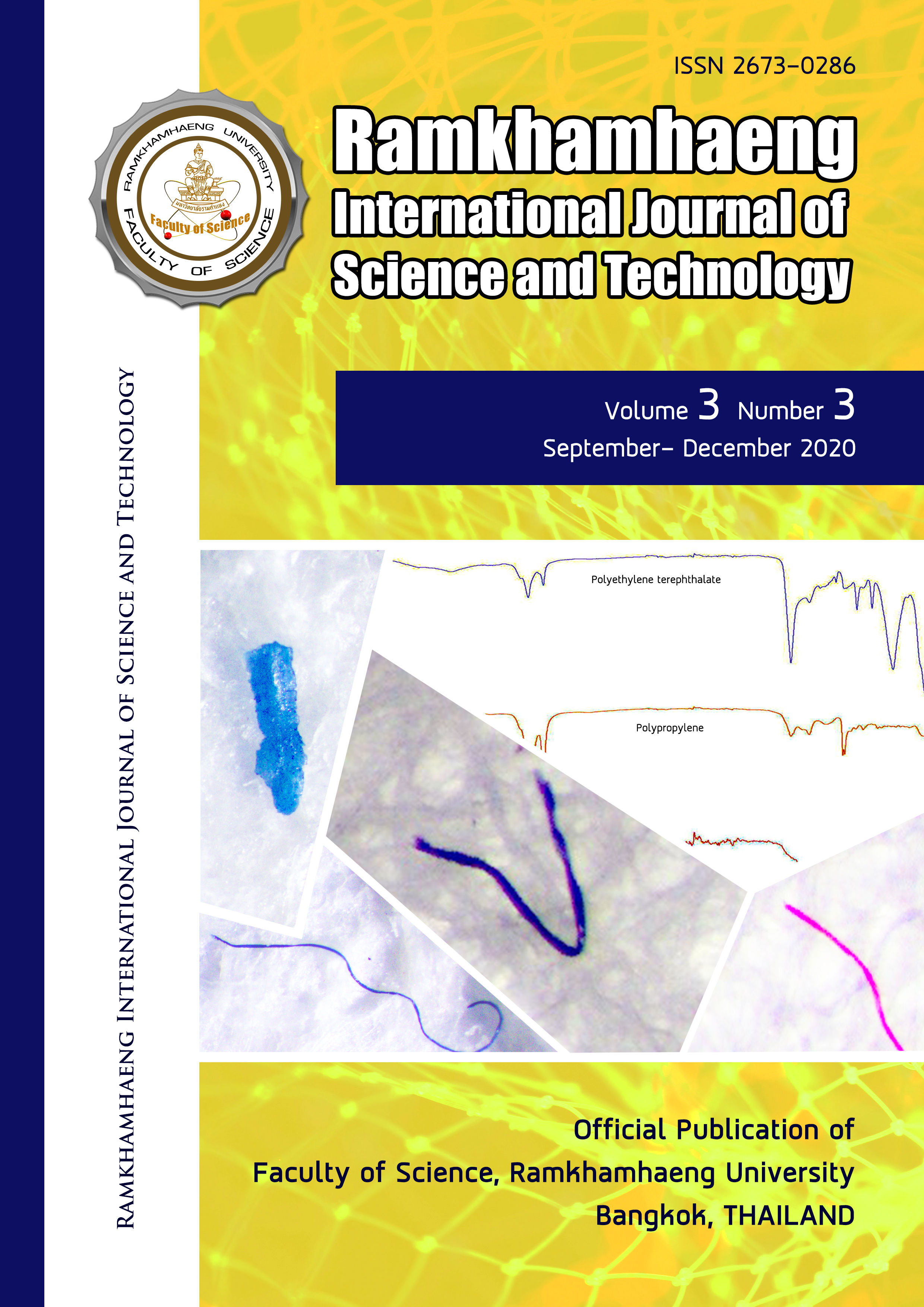Juvenile coral communities in Mu Ko Chumphon and Mu Ko Angthong, the Western Gulf of Thailand
Keywords:
juvenile coral, Gulf of Thailand, recovery, abundanceAbstract
Investigating coral recruitment is one of the most effective strategies to understand the recovery potential of coral reef communities subjected to natural and anthropogenic disturbances. The aim of this study was to survey the density and diversity of juvenile corals at two MPAs of the Western Gulf of Thailand. Seven study sites at Mu Ko Chumphon and six at Mu Ko Ang Thong were investigated by random 16x16cm quadrats to count and identify coral recruits (<5cm), while a belt transect was used to estimate the live coral cover. A total of 19 genera were identified among juveniles, being Pocillopora and Favites the most abundant. The highest and lowest percentage of live coral cover were found in Ko Ngam Noi and Ko Ngam Yai respectively, both in Chumphon. The last also held the highest density of coral recruits. There was a significant negative correlation between live coral cover and recruit density. Simper analysis indicate around 78% of dissimilarity between the two MPAs. The low density of recruits at some sites might be an effect of high sedimentation. High percentage of bare rock in Ko Ngam Yai may be skewing the correlation between recruit density and live coral cover. This study provides relevant information for reef management and the proper application of coral recovery projects.
References
Babcock, R., & Davies, P. (1991). Effects of sedimentation on settlement of Acropora millepora. Coral Reefs, 9(4), 205-208.
Edmunds, P.J.; McIlroy, S.E.; Adjeroud, M.;Ang, P.; Bergman, J.L.; Carpenter. R.C.; Coffroth ,M.A.; Fujimura, A.; Hench, J.; Holbrook, S.J.; Leichter, J.J.; Muko, S.; Nakajima, Y.; Nakamura, M.; Paris, C.B.; Schmitt, R.; Sutthacheep, M.; Toonen, R.; Sakai, K.; Suzuki, G.; Washburn, L.; Wyatt, A.S.J.; Mitarai, S. Critical information gaps impeding understanding of the role of larval connectivity among coral reef islands in an era of global change. Front. Ma. Sci. 2018, 5, 290. doi: 10.3389/fmars.2018.00290.
Gardner, T. A., Côté, I. M., Gill, J. A., Grant, A., & Watkinson, A. R. (2003). Long-term region-wide declines in Caribbean corals. science, 301(5635), 958-960.
Gilmour JP, Smith LD, Heyward AJ, Baird AH, Pratchett MS (2013) Recovery of an Isolated Coral Reef System Following Severe Disturbance. Science 340:69
Glassom, D., Chadwick, N.E., 2006. Recruitment, growth andmortality of juvenile corals at Eilat, northern Red Sea. Mar. Ecol. Prog. Ser. 318, 111–122.
Graham NA, Jennings S, MacNeil MA, Mouillot D, Wilson SK (2015) Predicting climate-driven regime shifts versus rebound potential in coral reefs. Nature 518:94–97
Graham NAJ, Nash KL, Kool JT (2011) Coral reef recovery dynamics in a changing world. Coral Reefs 30(2):283-294
Hoegh-Guldberg O, Mumby PJ, Hooten AJ, Steneck RS, Greenfield P, Gomez E, Harvell CD, Sale PF, Edwards AJ, Caldeira K, Knowlton N, Eakin M, Iglesias-Prieto R, Muthiga N, Bradbury RH, Dubi A, Hatziolos ME (2007) Coral reefs under rapid climate change and ocean acidification. Science 318: 1737–1742
Hoey, A.S., Pratchett, M.S., Cvitanovic, C., 2011. High macroalgal cover and low coral recruitment undermines the potential resilience of the world's southernmost coral reef assemblages. PLoS One 6, e25824.
Maliao, R. J., Turingan, R. G., & Lin, J. (2008). Phase-shift in coral reef communities in the Florida Keys National Marine Sanctuary (FKNMS), USA. Marine Biology, 154(5), 841-853.
McManus, J. W., & Polsenberg, J. F. (2004). Coral–algal phase shifts on coral reefs: ecological and environmental aspects. Progress in Oceanography, 60(2-4), 263-279.
Moeller, M., Nietzer, S., Schils, T., & Schupp, P. J. (2017). Low sediment loads affect survival of coral recruits: the first weeks are crucial. Coral Reefs, 36(1), 39-49.
Mora C, Graham NAJ, Nyström M (2016) Ecological limitations to the resilience of coral reefs. Coral Reefs 35:1271–1280
Nyström M, Norström AV, Blenckner T, de la Torre-Castro M, Eklöf JS, Folke C, Österblom H, Steneck RS, Thyresson M, Troell M (2012) Confronting feedbacks of degraded marine ecosystems. Ecosystems 15:695–710
Rützler K. 2002. Impact of crustose clionid sponges on Caribbean reef corals. Act Geol Hisp. 37:61–72.
Salinas-de-León, P., Costales-Carrera, A., Zeljkovic, S., Smith, D. J., & Bell, J. J. (2011). Scleractinian settlement patterns to natural cleared reef substrata and artificial settlement panels on an Indonesian coral reef. Estuarine, Coastal and Shelf Science, 93(1), 80-85.
Shlesinger, T.; Loya, Y. Recruitment, mortality, and resilience potential of scleractinian corals at Eilat, Red Sea. Coral Reefs 2016, 35, 1357–1368.
Sojisuporn, P.; Morimoto, A.; Yanagi, T. Seasonal variation of sea surface current in the Gulf of Thailand. Coast. Mar. Sci. 2010. 34(1): 1-12.
Sutthacheep, M.; Sakai, K.; Yeemin, T.; Pensakun, S.; Klinthong W.; Samsuvan, W. Assessing Coral Reef Resilience to Climate Change in Thailand. R. I. S. T. 2018, 1(1), 22–34.
Trapon,M.L., Pratchett, M.S., Hoey, A.S., 2013. Spatial variation in abundance, size and orientation of juvenile corals related to the biomass of parrotfishes on the Great Barrier Reef, Australia. PLoS One 8, e57788.
Yeemin, T.; Saenghaisuk, C.; Sutthacheep, M.; Pengsakun, S.; Klinthong, W.; Saengmanee, K Conditions of coral communities in the Gulf of Thailand: a decade after the 1998 bleaching event. Galaxea, J. Coral Reef Stud. 2009, 11, 207–217.
Downloads
Published
Issue
Section
License
Copyright Notice: a copyright on any article in the published journal is retained by the Ramkhamhaeng International Journal of Science and Technology. Readers or Users grant the right to use of the Article contained in the Content in accordance with the Creative Commons CC BY-NC-ND license and the Data contained in the Content in accordance with the Creative Commons CC BY-NC-ND.



